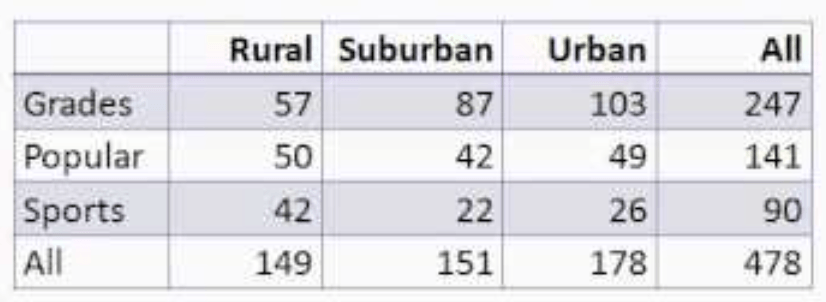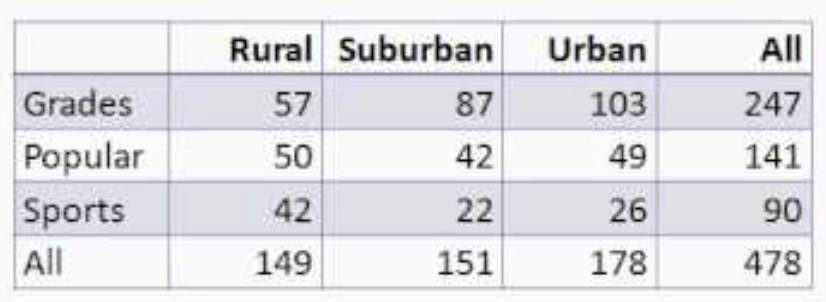How many 2-letter pairs of 1 vowel and 1 consonant can you make from the English alphabet? Consider "y" to be a consonant.
105
In a telephone survey of 150 households, 75 people answered “yes” to a particular question, 50 answered “no”, and 25 were “not sure”. Find the following experimental probability.
P(yes)
1/2 or 50%
Suppose you have seven CDs in a box. Four a rock, one is jazz, and two are country. Today you choose one CD without looking, play it, and put it back in the box. Tomorrow, you do the same thing. What is the probability that you choose a country CD both days?
4/49 or 8%
Researches asked students in grades 4 through 6 in three school districts in Michigan about what they thought was the most important thing in school: making good grades, being popular, or being good in sports. They were rural, suburban, and urban schools surveyed. Here is a breakdown of the results: Find P(popular|suburban)
42/151 or 28%
Determine whether the strategy described below results in a fair decision. Explain.
Mr. Lehmann wants to know what subject is hardest to teach at his district. He surveys all science teachers at every campus in his district.
A contestant winner gets to choose 1 of 8 possible vacations and bring 1 of 10 friends with her. How many different ways could the contest winner select her prize?
80
In a telephone survey of 150 households, 75 people answered “yes” to a particular question, 50 answered “no”, and 25 were “not sure”. Find the following experimental probability.
P(not sure)
1/6 or 17%
Suppose you have seven CDs in a box. Four a rock, one is jazz, and two are country. Today you choose one CD without looking, play it, and put it back in the box. Tomorrow, you do the same thing. What is the probability that you choose a country CD the first day and a rock CD the second day?
8/49 or 16%
Researches asked students in grades 4 through 6 in three school districts in Michigan about what they thought was the most important thing in school: making good grades, being popular, or being good in sports. They were rural, suburban, and urban schools surveyed. Here is a breakdown of the results: Find P(urban|sports)
13/45 or 29%
Determine whether the strategy described below results in a fair decision. Explain.
Mr. Counts is in charge of ordering lunch for the teachers in his hallway. He stands at the front office doorway and asks every teacher that he sees if they would prefer pizza or subs.
Fair; everyone has an equal chance of going to the office.
For the following situation, determine whether to use a permutation or a combination. Then solve the problem.
You draw the names of 5 raffle winners from a basket of 50 names. Each person wins the same prize. How many different groups of winners could you draw?
What is combination: 2,118,760?
In a telephone survey of 150 households, 75 people answered “yes” to a particular question, 50 answered “no”, and 25 were “not sure”. Find the following experimental probability.
P(yes or no or not sure)
1 or 100%
Suppose you have seven CDs in a box. Four a rock, one is jazz, and two are country. Today you choose one CD without looking, play it, and and do NOT put it back in the box. Tomorrow, you choose another CD without looking. What is the probability that you choose a country CD both days?
1/21 or 5%
Researches asked students in grades 4 through 6 in three school districts in Michigan about what they thought was the most important thing in school: making good grades, being popular, or being good in sports. They were rural, suburban, and urban schools surveyed. Here is a breakdown of the results: Find P(grades)

247/478 or 52%
Determine whether the strategy described below results in a fair decision. Explain.
Mr. Hultberg thinks that students at DLHS should receive 30 math problems for homework four days a week. He uses a computer program to produce a random list of his student names for his survey.
Fair; each student has an equal chance of being selected.
For the following situation, determine whether to use a permutation or a combination. Then solve the problem.
How many different 5-letter codes can you make from the letters in the word cipher?
permutation: 720
In a telephone survey of 150 households, 75 people answered “yes” to a particular question, 50 answered “no”, and 25 were “not sure”. Find the following experimental probability.
P(yes or not sure)
2/3 or 67%
Suppose you have seven CDs in a box. Four a rock, one is jazz, and two are country. Today you choose one CD without looking, play it, and and do NOT put it back in the box. Tomorrow, you choose another CD without looking. What is the probability that you choose a country CD on the first day and a jazz CD on the second day?
1/21 or 5%
Researches asked students in grades 4 through 6 in three school districts in Michigan about what they thought was the most important thing in school: making good grades, being popular, or being good in sports. They were rural, suburban, and urban schools surveyed. Here is a breakdown of the results: Find P(rural|grades)

57/247 or 23%
Determine whether the strategy described below results in a fair decision. Explain.
Mr. Potter wants to know what his students' favorite pizza topping was. As his students came into the classroom he randomly asked every third student.
Unfair; some students may have to walk further to class effecting their placement in line or some students may be absent that day.
For the following situation, determine whether to use a permutation or a combination. Then solve the problem.
A horse race has 12 horses. How many ways can 1st, 2nd, and 3rd place occur?
Permutation: 1320
In a telephone survey of 150 households, 75 people answered “yes” to a particular question, 50 answered “no”, and 25 were “not sure”. Find the following experimental probability.
P(yes and not sure)
0 or 0%
Suppose you have seven CDs in a box. Four a rock, one is jazz, and two are country. Today you choose one CD without looking, play it, and and do NOT put it back in the box. Tomorrow, you choose another CD without looking. What is the probability that you choose a rock CD both days?
2/7 or 29%
Researches asked students in grades 4 through 6 in three school districts in Michigan about what they thought was the most important thing in school: making good grades, being popular, or being good in sports. They were rural, suburban, and urban schools surveyed. Here is a breakdown of the results: Find P(urban)

89/239 or 37%
Determine whether the strategy described below results in a fair decision. Explain.
Tate vs Gerardo in wrestling.
Unfair; not equally suited to compete against each other.